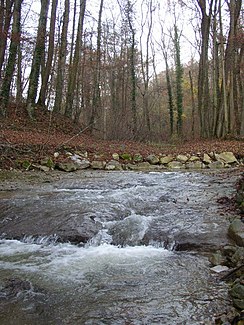Morges (river)
| Morges | ||
|
The Morges |
||
| Data | ||
| Water code | CH : 163 | |
| location | Canton of Vaud , Switzerland | |
| River system | Rhone | |
| Drain over | Rhone → Mediterranean | |
| source | at Apple's 46 ° 33 ′ 41 ″ N , 6 ° 26 ′ 18 ″ E |
|
| muzzle | near Morges on Lake Geneva Coordinates: 46 ° 30 ′ 14 " N , 6 ° 29 ′ 40" E ; CH1903: 527 525 / 150724 46 ° 30 '14 " N , 6 ° 29' 40" O
|
|
| length | approx. 14 km | |
The Morges is an approximately 14 km long tributary of Lake Geneva in the canton of Vaud in Switzerland . It drains a section of the Waadtländer Mittelland and belongs to the catchment area of the Rhone . The name is derived from the old French word morge (border river). It should not be confused with the Morge , which flows into Lake Geneva on the border between Switzerland and France .
The headwaters of the Morges are located at around 640 m above sea level. M. on the edge of the Jura foot plateau on the Le Marais corridor between the village of Apples and the Bois de Saint-Pierre forest area to the north . As a small trickle, the Morges initially flows around 3 km to the northeast, until it reaches Cottens (VD) at 566 m above sea level. M. reached a valley. Here the Combagnou flows from the left , which rises in the extensive Bois de Fermens on the Jura foot plateau and has already covered a distance of 5.5 km to this point. The Combagnou usually has more water than the Morges.
The Morges is now turning south in a sharp bend. It now flows through a wide basin and reaches a wide basin below Apples, into which the second notable tributary flows from the right, the Curbit . Below this confluence, the Morges assumes a south-easterly direction of flow and crosses the surrounding plateaus in a 50 to 70 m deep erosion valley . It then reaches the flat shoreline of Lake Geneva and flows into the lake west of the old town of Morges at the castle.
With the exception of the section of the lower course in the settlement area of Morges, the course of the brook is largely preserved in its natural state, partly also in its natural state.
In 1897 , the molar tooth of a hippopotamus (Hippopotamus pentlandi) that lived during the Pleistocene around 1.8 million years ago was found in layers of earth that had been deposited by the Morges over time on the alluvial cone at the confluence with Lake Geneva . The find is exhibited today in the Musée cantonal de géologie in Lausanne .
